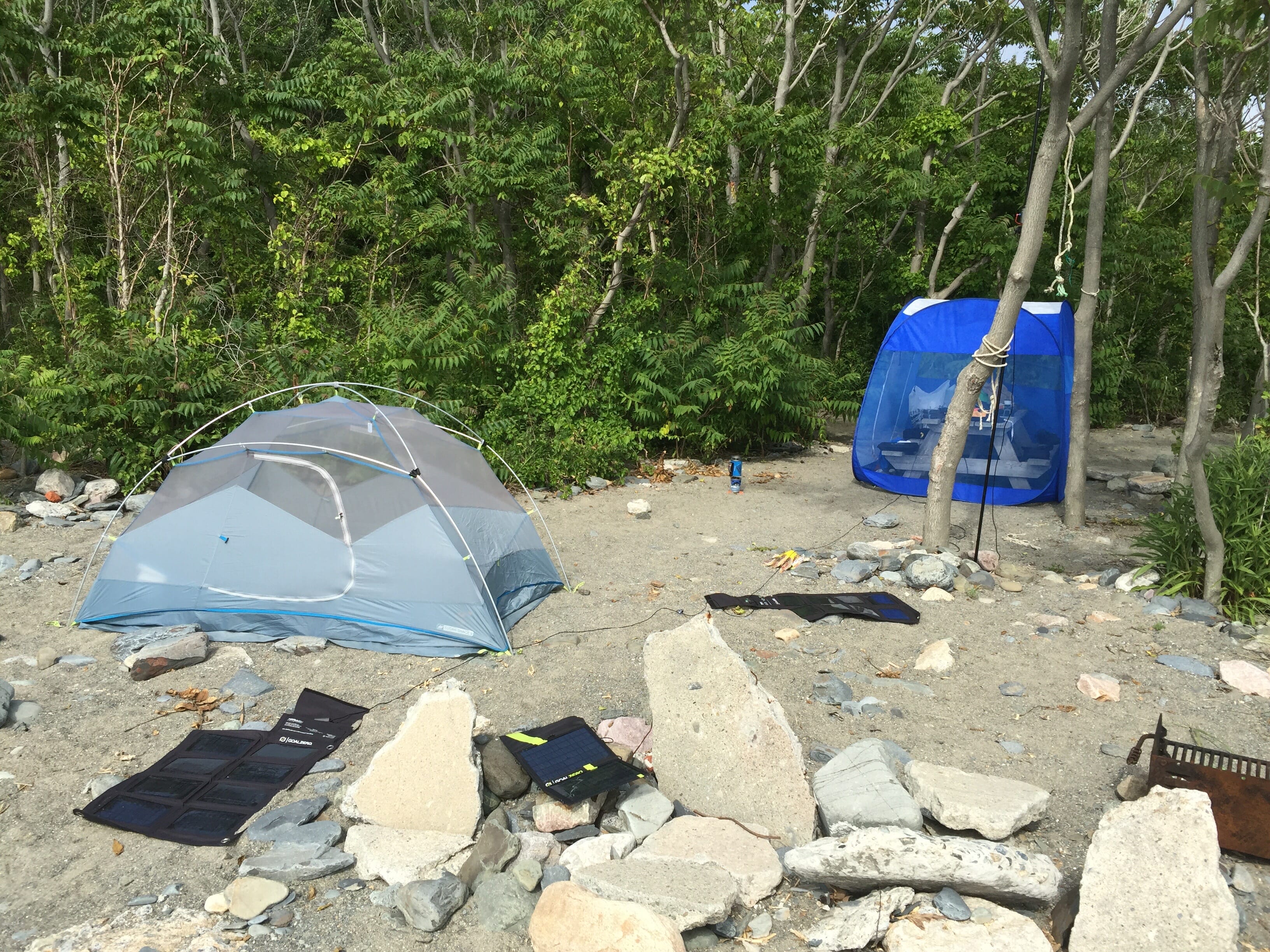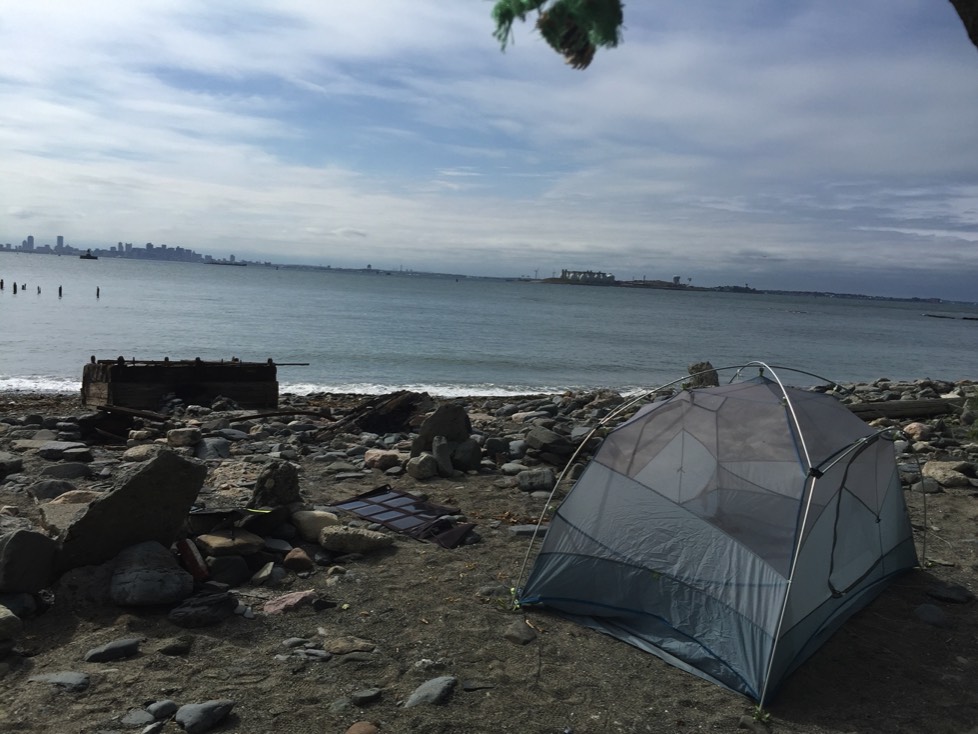QRP Operation from Boston Harbor Islands

The British program Islands on the Air (www.rsgbiota.org) gives participants an opportunity to collect islands much like the ARRL’s DXCC program collects countries (entities). As it turns out, because there is no commercial power (mains) available to the public, the Boston Harbor Islands are somewhat rare (being claimed by only 30.2% of IOTA participants). It is a lot harder to get on the air and be heard when it is only battery and solar power driving things. That makes the challenge even more fun. And, when you are heard, you’ve often got a pileup!
The US Islands Awards Program (www.usislands.org) is similar to the IOTA program, except it accepts islands anywhere in the United States. (The IOTA program only counts islands that are true “sea” islands.) Lovells Island in Boston Harbor has the designation MA042S, and I was lucky enough to be the first to activate it for this program.
These mini-DXpeditions to Boston Harbor Islands begin at home, sorting, selecting, and packing the items needed for a successful activation. For day trips to Georges Island, the largest of the group, and the main destination for the Boston-to-island ferry service, I concentrate on packing just the bare essentials of radio, antenna, coax, rope, and so on.

Maybe a little more than a 100 pound DXpedition this time. Lovells Island offers campgrounds but no water. Y
ou must bring your own. At about 8 pounds per gallon, things get heavy in a hurry.
Once off the boat on Georges, I hike quickly to a picnic table near a tree. No trees on this island are very tall, so there are no prospects for running wire dipoles or other wire antennas. Instead, I build a vertical antenna from a mini-Buddipole (www.buddipole.com) kit. I will often lash the shock-cord mast to one of these short trees to hold it up. The wires from my home-brew four-wire radial kit also serve as guys for the setup. Assembly is usually quick (under ten minutes) and a quick check with an antenna analyzer confirms the antenna is resonant.

Georges Island and Lovells Island are about seven miles out to sea in Boston Harbor. They offer a great day trip, or camping (on Lovells).
Day trips with only a couple of hours of operation need only a battery, but I find that I bring a solar panel out of habit. With the panel connected, I usually leave with my battery fully charged. Running without the panel would also work, but I’m unwilling to take a chance that my day would be cut short because of power problems.

The operation on Lovells Island includes a pop-up enclosure that fits over a picnic table, and a tent for sleeping.
Two 20-Watt and one 13-Watt solar panels are visible in the foreground among the rocks.
Getting to Lovells is also more difficult. The ferry shuttles between Georges Island, a few other large islands, and Boston Harbor’s Long Warf. Connections to Lovells Island are made from Georges, and only occur three times per day. Once that last boat has left, you are stuck on Lovells until the next morning. You better have everything you need! That includes food, water, first aid supplies, power for your phone and radio, and anything else needed for a successful camping trip.

NE1RD Power and Light. Multiday QRP operations depend on a good power source.
Two 20-Watt panels are connected in series to the GoalZero Sherpa 50 battery. The small 13-Watt panel on the rocks is recharging my phone.
I’ve had good luck with two EFHW antenna models. PAR EndFedZ antennas (www.lnrprecision.com) offer a trail-friendly antenna good for 10-20-40m that easily handles QRP power. This packs small and is light.
Intrigued by an advertisement on the ARRL website, I ordered and tried the MyAntennas (www.myantennas.com) EFHW-8010, a multiband antenna good from 80m through 10m that can also handle high power. On my last camping trip, I was very lucky to get my first throw through the tree in a good spot, and this EFHW antenna was up and running in about thirty minutes. It performed very well and will be in my pack on future trips.
Camping on Lovells is primitive. The park service offers chemical toilets, and cleared areas with picnic tables, but nothing else. You must bring your own water. Budget at least a gallon a day, and more if it’s hot. Suddenly, a three-day camping trip can get bulky and heavy! I’ve tried several “beach carts” and may have finally found one that is robust enough to handle the weight of all my gear, and the rough terrain of the island. Remember to bring everything you need to pack out your trash, too. Good campers leave nothing but footprints.

Operating begins after camp is assembled, and I’ve had a short rest. These trips often happen in July or August, and it can be hot and sticky on these islands. Beware dehydration and overheating. When operating in a remote area, help may not be just a phone call away. It is important to take care of yourself first.
In three trips out to the islands in 2016, including two camping trips, I made 343 QSOs to 18 DXCC entities and 42 states. I’m going to work on completing my Worked All States award from these islands next year! That said, it isn’t just my awards program that keeps me going. I know that I’ve made it possible for other hams to work these islands for the IOTA program, the US Islands program, and even Worked All States. It is gratifying to hear, “Thanks for the new one!” several times during each trip.

Nighttime is a great time to operate. The pop-up enclosure over the picnic table protects me from pests, even with the lights on.


